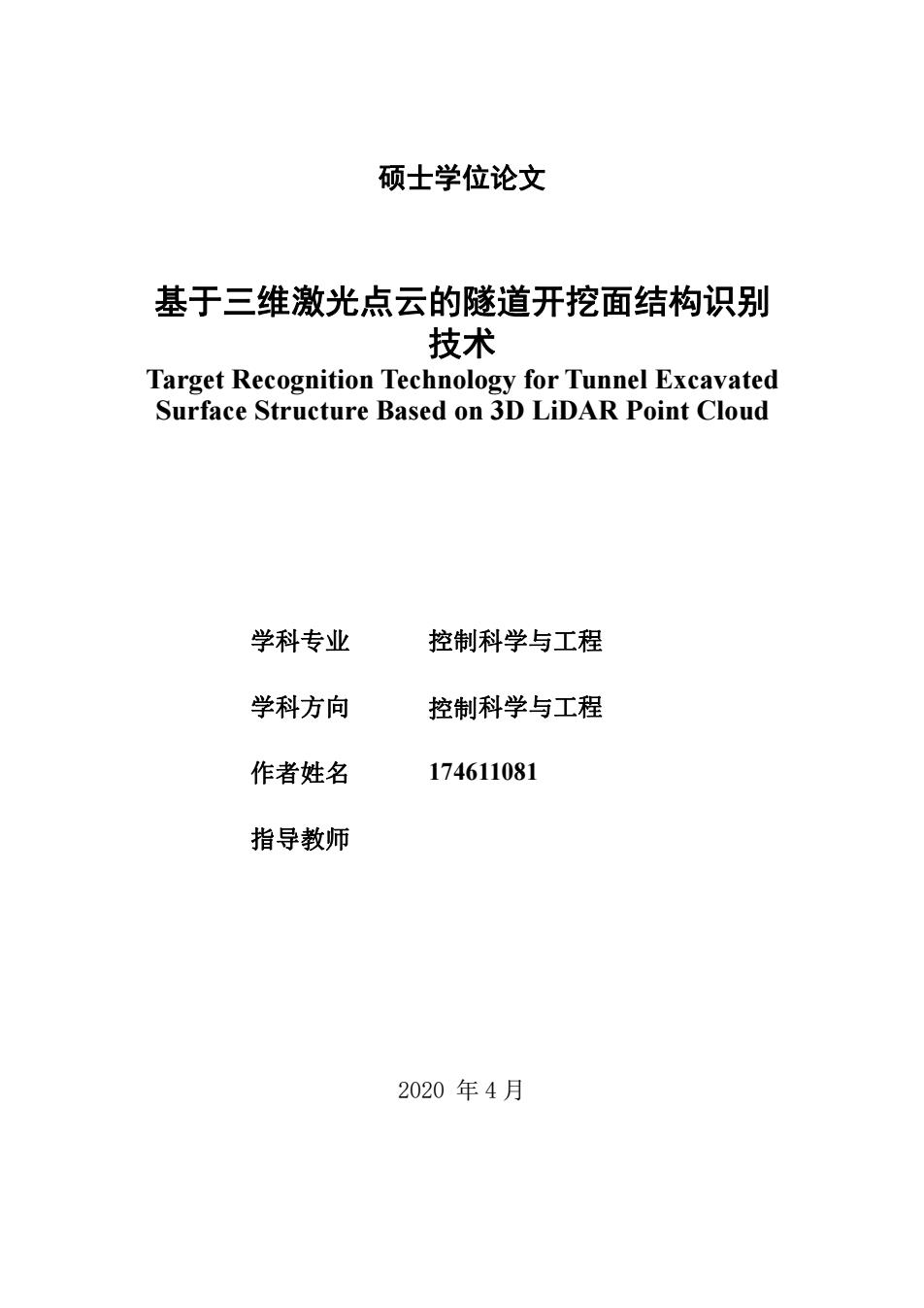
硕士学位论文 基于三维激光点云的隧道开挖面结构识别 技术 Target Recognition Technology for Tunnel Excavated Surface Structure Based on 3D LiDAR Point Cloud 学科专业 控制科学与工程 学科方向 控制科学与工程 作者姓名 174611081 指导教师 2020年4月
硕士学位论文 基于三维激光点云的隧道开挖面结构识别 技术 Target Recognition Technology for Tunnel Excavated Surface Structure Based on 3D LiDAR Point Cloud 学科专业 控制科学与工程 学科方向 控制科学与工程 作者姓名 174611081 指导教师 2020 年 4 月
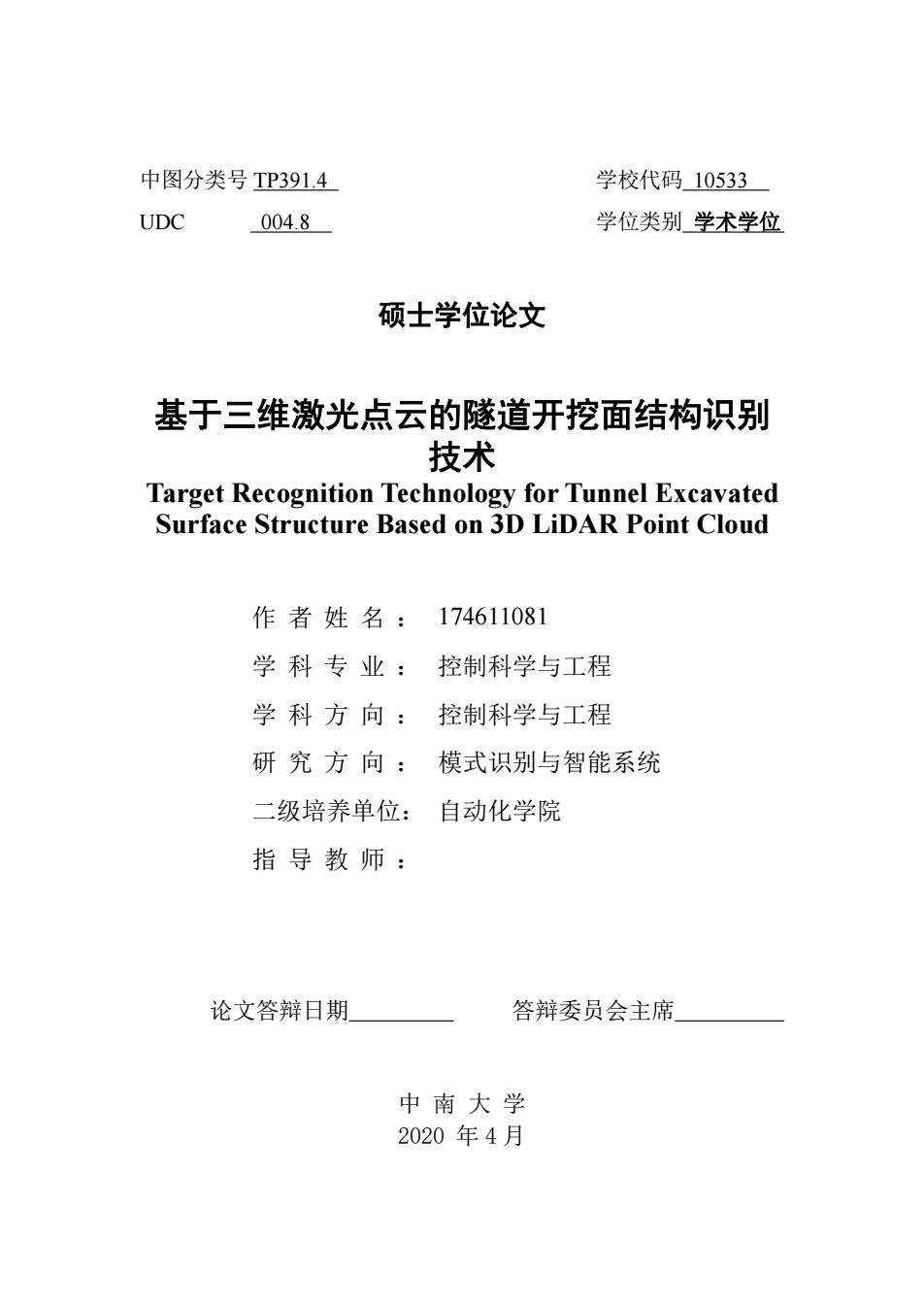
中图分类号TP3914 学校代码10533 UDC 004.8 学位类别学术学位 硕士学位论文 基于三维激光点云的隧道开挖面结构识别 技术 Target Recognition Technology for Tunnel Excavated Surface Structure Based on 3D LiDAR Point Cloud 作者姓名:174611081 学科专业:控制科学与工程 学科方向:控制科学与工程 研究方向:模式识别与智能系统 二级培养单位:自动化学院 指导教师: 论文答辩日期 答辩委员会主席 中南大学 2020年4月
中图分类号 TP391.4 学校代码 10533 UDC 004.8 学位类别 学术学位 硕士学位论文 基于三维激光点云的隧道开挖面结构识别 技术 Target Recognition Technology for Tunnel Excavated Surface Structure Based on 3D LiDAR Point Cloud 作 者 姓 名 : 174611081 学 科 专 业 : 控制科学与工程 学 科 方 向 : 控制科学与工程 研 究 方 向 : 模式识别与智能系统 二级培养单位: 自动化学院 指 导 教 师 : 论文答辩日期 答辩委员会主席 中 南 大 学 2020 年 4 月
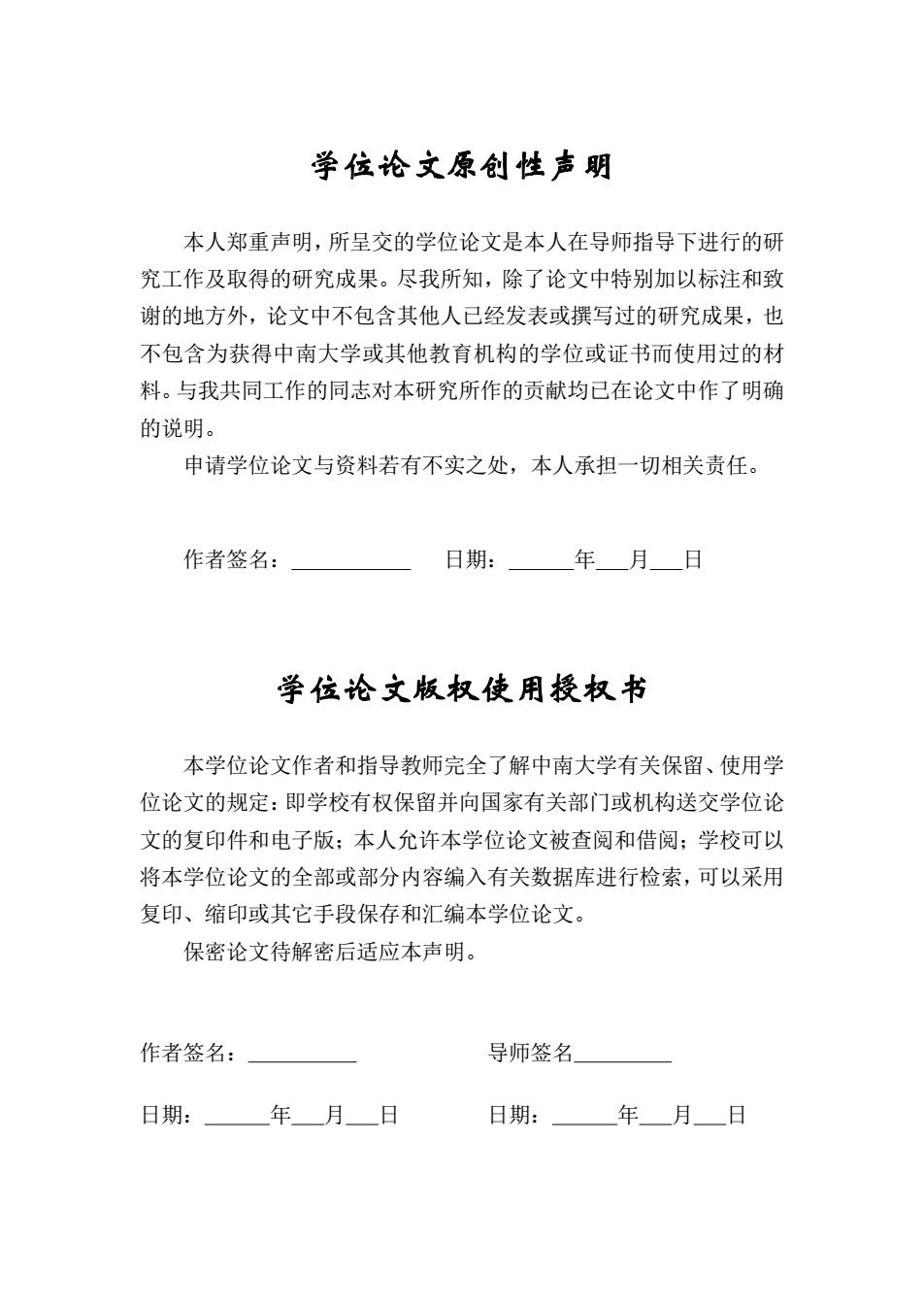
学位论文原创性声明 本人郑重声明,所呈交的学位论文是本人在导师指导下进行的研 究工作及取得的研究成果。尽我所知,除了论文中特别加以标注和致 谢的地方外,论文中不包含其他人已经发表或撰写过的研究成果,也 不包含为获得中南大学或其他教育机构的学位或证书而使用过的材 料。与我共同工作的同志对本研究所作的贡献均已在论文中作了明确 的说明。 申请学位论文与资料若有不实之处,本人承担一切相关责任。 作者签名: 日期:年月日 学位论文版权使用授权书 本学位论文作者和指导教师完全了解中南大学有关保留、使用学 位论文的规定:即学校有权保留并向国家有关部门或机构送交学位论 文的复印件和电子版:本人允许本学位论文被查阅和借阅;学校可以 将本学位论文的全部或部分内容编入有关数据库进行检索,可以采用 复印、缩印或其它手段保存和汇编本学位论文。 保密论文待解密后适应本声明。 作者签名: 导师签名」 日期:年月日 日期:年月日
学位论文原创性声明 本人郑重声明,所呈交的学位论文是本人在导师指导下进行的研 究工作及取得的研究成果。尽我所知,除了论文中特别加以标注和致 谢的地方外,论文中不包含其他人已经发表或撰写过的研究成果,也 不包含为获得中南大学或其他教育机构的学位或证书而使用过的材 料。与我共同工作的同志对本研究所作的贡献均已在论文中作了明确 的说明。 申请学位论文与资料若有不实之处,本人承担一切相关责任。 作者签名: 日期: 年 月 日 学位论文版权使用授权书 本学位论文作者和指导教师完全了解中南大学有关保留、使用学 位论文的规定:即学校有权保留并向国家有关部门或机构送交学位论 文的复印件和电子版;本人允许本学位论文被查阅和借阅;学校可以 将本学位论文的全部或部分内容编入有关数据库进行检索,可以采用 复印、缩印或其它手段保存和汇编本学位论文。 保密论文待解密后适应本声明。 作者签名: 导师签名 日期: 年 月 日 日期: 年 月 日
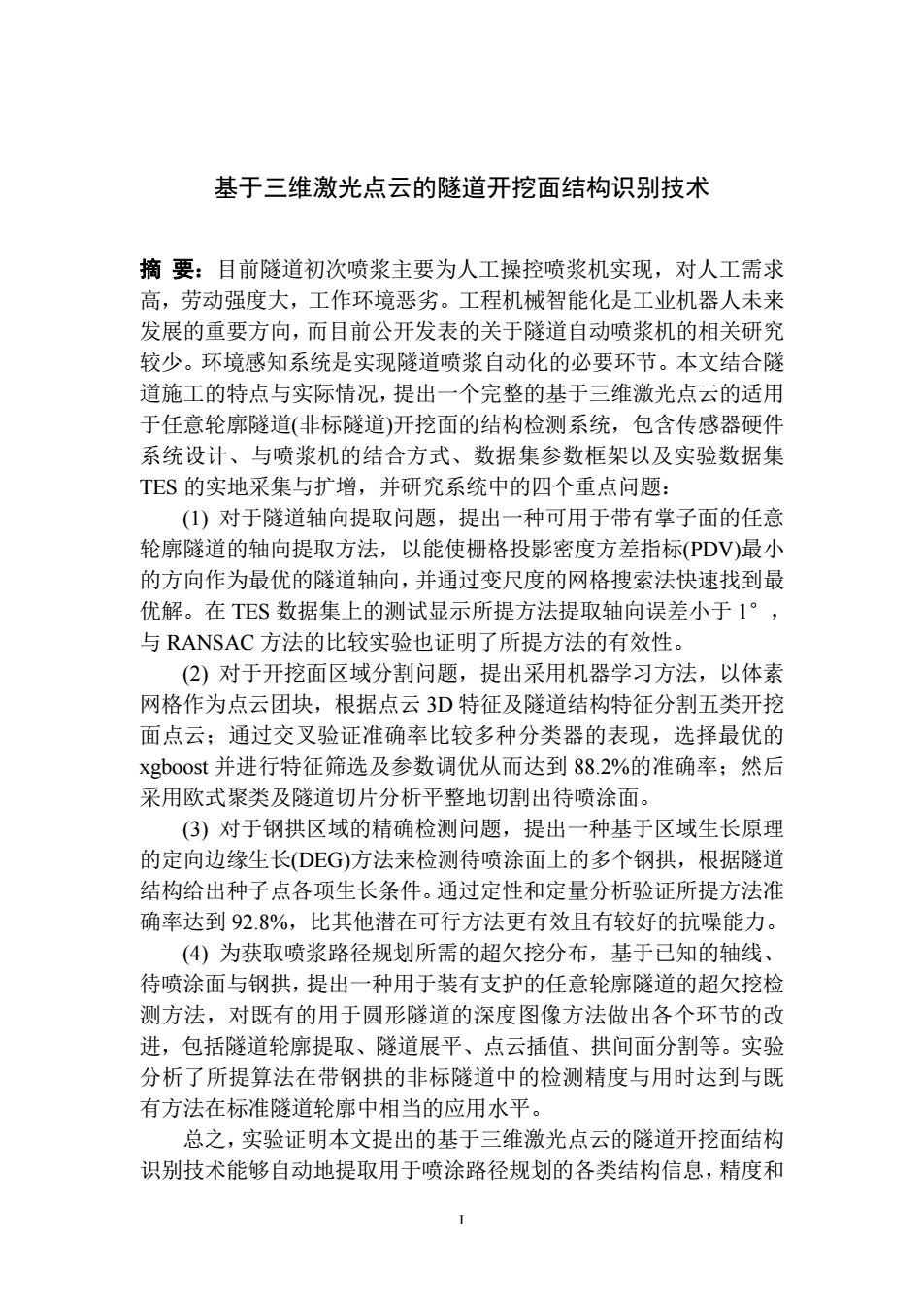
基于三维激光点云的隧道开挖面结构识别技术 摘要:目前隧道初次喷浆主要为人工操控喷浆机实现,对人工需求 高,劳动强度大,工作环境恶劣。工程机械智能化是工业机器人未来 发展的重要方向,而目前公开发表的关于隧道自动喷浆机的相关研究 较少。环境感知系统是实现隧道喷浆自动化的必要环节。本文结合隧 道施工的特点与实际情况,提出一个完整的基于三维激光点云的适用 于任意轮廓隧道(非标隧道)开挖面的结构检测系统,包含传感器硬件 系统设计、与喷浆机的结合方式、数据集参数框架以及实验数据集 TES的实地采集与扩增,并研究系统中的四个重点问题: (1)对于隧道轴向提取问题,提出一种可用于带有掌子面的任意 轮廓隧道的轴向提取方法,以能使栅格投影密度方差指标(PDV)最小 的方向作为最优的隧道轴向,并通过变尺度的网格搜索法快速找到最 优解。在TES数据集上的测试显示所提方法提取轴向误差小于1°, 与RANSAC方法的比较实验也证明了所提方法的有效性。 (2)对于开挖面区域分割问题,提出采用机器学习方法,以体素 网格作为点云团块,根据点云3D特征及隧道结构特征分割五类开挖 面点云:通过交叉验证准确率比较多种分类器的表现,选择最优的 xgboost并进行特征筛选及参数调优从而达到882%的准确率:然后 采用欧式聚类及隧道切片分析平整地切割出待喷涂面。 (3)对于钢拱区域的精确检测问题,提出一种基于区域生长原理 的定向边缘生长(DEG)方法来检测待喷涂面上的多个钢拱,根据隧道 结构给出种子点各项生长条件。通过定性和定量分析验证所提方法准 确率达到92.8%,比其他潜在可行方法更有效且有较好的抗噪能力。 (4)为获取喷浆路径规划所需的超欠挖分布,基于已知的轴线、 待喷涂面与钢拱,提出一种用于装有支护的任意轮廓隧道的超欠挖检 测方法,对既有的用于圆形隧道的深度图像方法做出各个环节的改 进,包括隧道轮廓提取、隧道展平、点云插值、拱间面分割等。实验 分析了所提算法在带钢拱的非标隧道中的检测精度与用时达到与既 有方法在标准隧道轮廓中相当的应用水平。 总之,实验证明本文提出的基于三维激光点云的隧道开挖面结构 识别技术能够自动地提取用于喷涂路径规划的各类结构信息,精度和
I 基于三维激光点云的隧道开挖面结构识别技术 摘 要:目前隧道初次喷浆主要为人工操控喷浆机实现,对人工需求 高,劳动强度大,工作环境恶劣。工程机械智能化是工业机器人未来 发展的重要方向,而目前公开发表的关于隧道自动喷浆机的相关研究 较少。环境感知系统是实现隧道喷浆自动化的必要环节。本文结合隧 道施工的特点与实际情况,提出一个完整的基于三维激光点云的适用 于任意轮廓隧道(非标隧道)开挖面的结构检测系统,包含传感器硬件 系统设计、与喷浆机的结合方式、数据集参数框架以及实验数据集 TES 的实地采集与扩增,并研究系统中的四个重点问题: (1) 对于隧道轴向提取问题,提出一种可用于带有掌子面的任意 轮廓隧道的轴向提取方法,以能使栅格投影密度方差指标(PDV)最小 的方向作为最优的隧道轴向,并通过变尺度的网格搜索法快速找到最 优解。在 TES 数据集上的测试显示所提方法提取轴向误差小于 1°, 与 RANSAC 方法的比较实验也证明了所提方法的有效性。 (2) 对于开挖面区域分割问题,提出采用机器学习方法,以体素 网格作为点云团块,根据点云 3D 特征及隧道结构特征分割五类开挖 面点云;通过交叉验证准确率比较多种分类器的表现,选择最优的 xgboost 并进行特征筛选及参数调优从而达到 88.2%的准确率;然后 采用欧式聚类及隧道切片分析平整地切割出待喷涂面。 (3) 对于钢拱区域的精确检测问题,提出一种基于区域生长原理 的定向边缘生长(DEG)方法来检测待喷涂面上的多个钢拱,根据隧道 结构给出种子点各项生长条件。通过定性和定量分析验证所提方法准 确率达到 92.8%,比其他潜在可行方法更有效且有较好的抗噪能力。 (4) 为获取喷浆路径规划所需的超欠挖分布,基于已知的轴线、 待喷涂面与钢拱,提出一种用于装有支护的任意轮廓隧道的超欠挖检 测方法,对既有的用于圆形隧道的深度图像方法做出各个环节的改 进,包括隧道轮廓提取、隧道展平、点云插值、拱间面分割等。实验 分析了所提算法在带钢拱的非标隧道中的检测精度与用时达到与既 有方法在标准隧道轮廓中相当的应用水平。 总之,实验证明本文提出的基于三维激光点云的隧道开挖面结构 识别技术能够自动地提取用于喷涂路径规划的各类结构信息,精度和

识别速度上也能基本能符合实际工况的需求。本文的研究工作具有用 于隧道全自动喷浆的可行性,填补了相关领域的研究空白,对推动全 自动隧道喷浆机产业落地也有一定的工程应用价值。 图62幅,表22个,参考文献89篇 关键词:计算机视觉:三维点云;激光雷达;隧道喷浆:机器学习 分类号:TP391.4
II 识别速度上也能基本能符合实际工况的需求。本文的研究工作具有用 于隧道全自动喷浆的可行性,填补了相关领域的研究空白,对推动全 自动隧道喷浆机产业落地也有一定的工程应用价值。 图 62 幅,表 22 个,参考文献 89 篇 关键词:计算机视觉;三维点云;激光雷达;隧道喷浆;机器学习 分类号:TP391.4
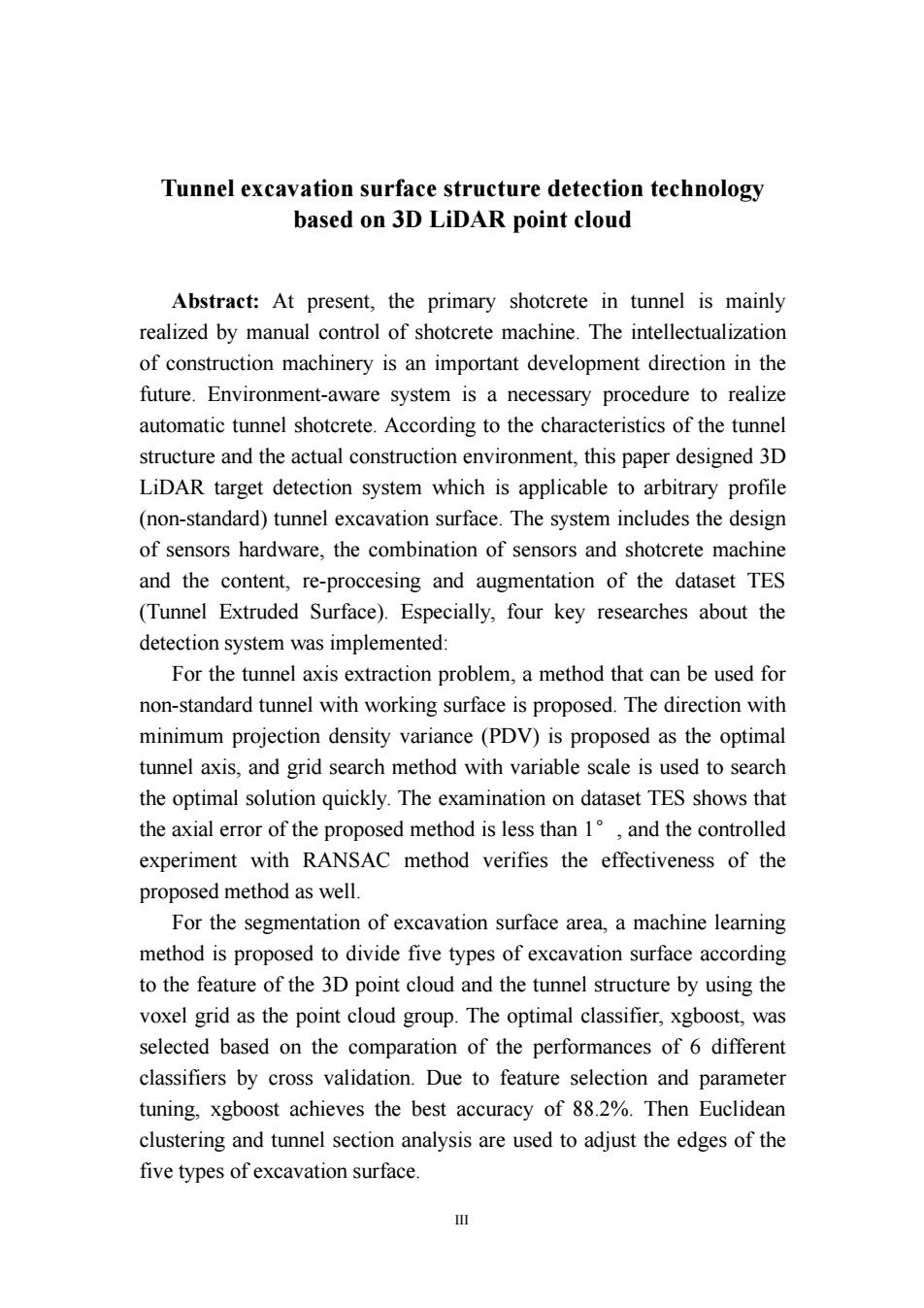
Tunnel excavation surface structure detection technology based on 3D LiDAR point cloud Abstract:At present,the primary shotcrete in tunnel is mainly realized by manual control of shotcrete machine.The intellectualization of construction machinery is an important development direction in the future.Environment-aware system is a necessary procedure to realize automatic tunnel shotcrete.According to the characteristics of the tunnel structure and the actual construction environment,this paper designed 3D LiDAR target detection system which is applicable to arbitrary profile (non-standard)tunnel excavation surface.The system includes the design of sensors hardware,the combination of sensors and shotcrete machine and the content,re-proccesing and augmentation of the dataset TES (Tunnel Extruded Surface).Especially,four key researches about the detection system was implemented: For the tunnel axis extraction problem,a method that can be used for non-standard tunnel with working surface is proposed.The direction with minimum projection density variance(PDV)is proposed as the optimal tunnel axis,and grid search method with variable scale is used to search the optimal solution quickly.The examination on dataset TES shows that the axial error of the proposed method is less than 1,and the controlled experiment with RANSAC method verifies the effectiveness of the proposed method as well. For the segmentation of excavation surface area,a machine learning method is proposed to divide five types of excavation surface according to the feature of the 3D point cloud and the tunnel structure by using the voxel grid as the point cloud group.The optimal classifier,xgboost,was selected based on the comparation of the performances of 6 different classifiers by cross validation.Due to feature selection and parameter tuning,xgboost achieves the best accuracy of 88.2%.Then Euclidean clustering and tunnel section analysis are used to adjust the edges of the five types of excavation surface
III Tunnel excavation surface structure detection technology based on 3D LiDAR point cloud Abstract: At present, the primary shotcrete in tunnel is mainly realized by manual control of shotcrete machine. The intellectualization of construction machinery is an important development direction in the future. Environment-aware system is a necessary procedure to realize automatic tunnel shotcrete. According to the characteristics of the tunnel structure and the actual construction environment, this paper designed 3D LiDAR target detection system which is applicable to arbitrary profile (non-standard) tunnel excavation surface. The system includes the design of sensors hardware, the combination of sensors and shotcrete machine and the content, re-proccesing and augmentation of the dataset TES (Tunnel Extruded Surface). Especially, four key researches about the detection system was implemented: For the tunnel axis extraction problem, a method that can be used for non-standard tunnel with working surface is proposed. The direction with minimum projection density variance (PDV) is proposed as the optimal tunnel axis, and grid search method with variable scale is used to search the optimal solution quickly. The examination on dataset TES shows that the axial error of the proposed method is less than 1°, and the controlled experiment with RANSAC method verifies the effectiveness of the proposed method as well. For the segmentation of excavation surface area, a machine learning method is proposed to divide five types of excavation surface according to the feature of the 3D point cloud and the tunnel structure by using the voxel grid as the point cloud group. The optimal classifier, xgboost, was selected based on the comparation of the performances of 6 different classifiers by cross validation. Due to feature selection and parameter tuning, xgboost achieves the best accuracy of 88.2%. Then Euclidean clustering and tunnel section analysis are used to adjust the edges of the five types of excavation surface
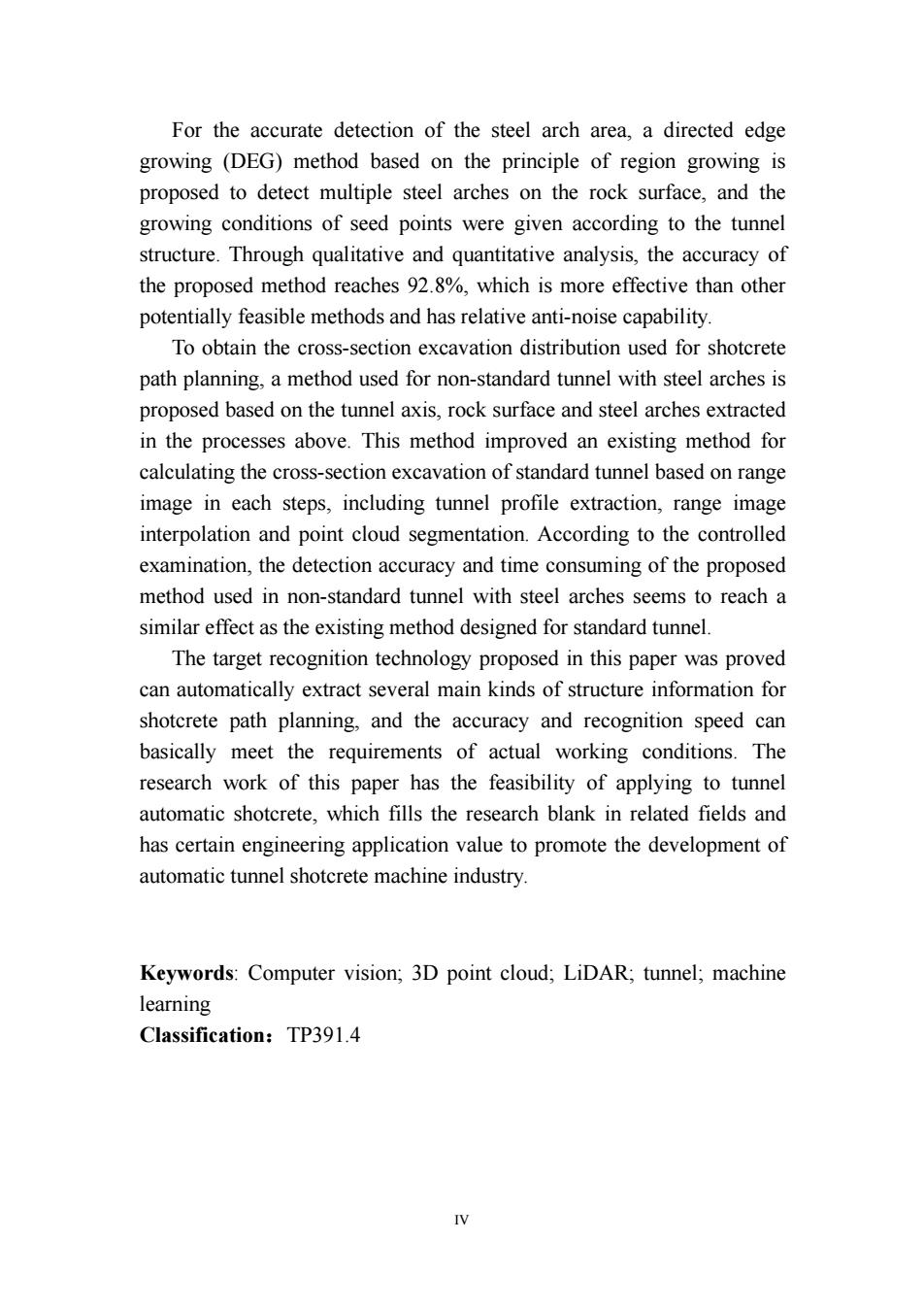
For the accurate detection of the steel arch area,a directed edge growing (DEG)method based on the principle of region growing is proposed to detect multiple steel arches on the rock surface,and the growing conditions of seed points were given according to the tunnel structure.Through qualitative and quantitative analysis,the accuracy of the proposed method reaches 92.8%,which is more effective than other potentially feasible methods and has relative anti-noise capability. To obtain the cross-section excavation distribution used for shotcrete path planning,a method used for non-standard tunnel with steel arches is proposed based on the tunnel axis,rock surface and steel arches extracted in the processes above.This method improved an existing method for calculating the cross-section excavation of standard tunnel based on range image in each steps,including tunnel profile extraction,range image interpolation and point cloud segmentation.According to the controlled examination,the detection accuracy and time consuming of the proposed method used in non-standard tunnel with steel arches seems to reach a similar effect as the existing method designed for standard tunnel The target recognition technology proposed in this paper was proved can automatically extract several main kinds of structure information for shotcrete path planning,and the accuracy and recognition speed can basically meet the requirements of actual working conditions.The research work of this paper has the feasibility of applying to tunnel automatic shotcrete,which fills the research blank in related fields and has certain engineering application value to promote the development of automatic tunnel shotcrete machine industry. Keywords:Computer vision;3D point cloud;LiDAR;tunnel;machine learning Classification:TP391.4
IV For the accurate detection of the steel arch area, a directed edge growing (DEG) method based on the principle of region growing is proposed to detect multiple steel arches on the rock surface, and the growing conditions of seed points were given according to the tunnel structure. Through qualitative and quantitative analysis, the accuracy of the proposed method reaches 92.8%, which is more effective than other potentially feasible methods and has relative anti-noise capability. To obtain the cross-section excavation distribution used for shotcrete path planning, a method used for non-standard tunnel with steel arches is proposed based on the tunnel axis, rock surface and steel arches extracted in the processes above. This method improved an existing method for calculating the cross-section excavation of standard tunnel based on range image in each steps, including tunnel profile extraction, range image interpolation and point cloud segmentation. According to the controlled examination, the detection accuracy and time consuming of the proposed method used in non-standard tunnel with steel arches seems to reach a similar effect as the existing method designed for standard tunnel. The target recognition technology proposed in this paper was proved can automatically extract several main kinds of structure information for shotcrete path planning, and the accuracy and recognition speed can basically meet the requirements of actual working conditions. The research work of this paper has the feasibility of applying to tunnel automatic shotcrete, which fills the research blank in related fields and has certain engineering application value to promote the development of automatic tunnel shotcrete machine industry. Keywords: Computer vision; 3D point cloud; LiDAR; tunnel; machine learning Classification:TP391.4
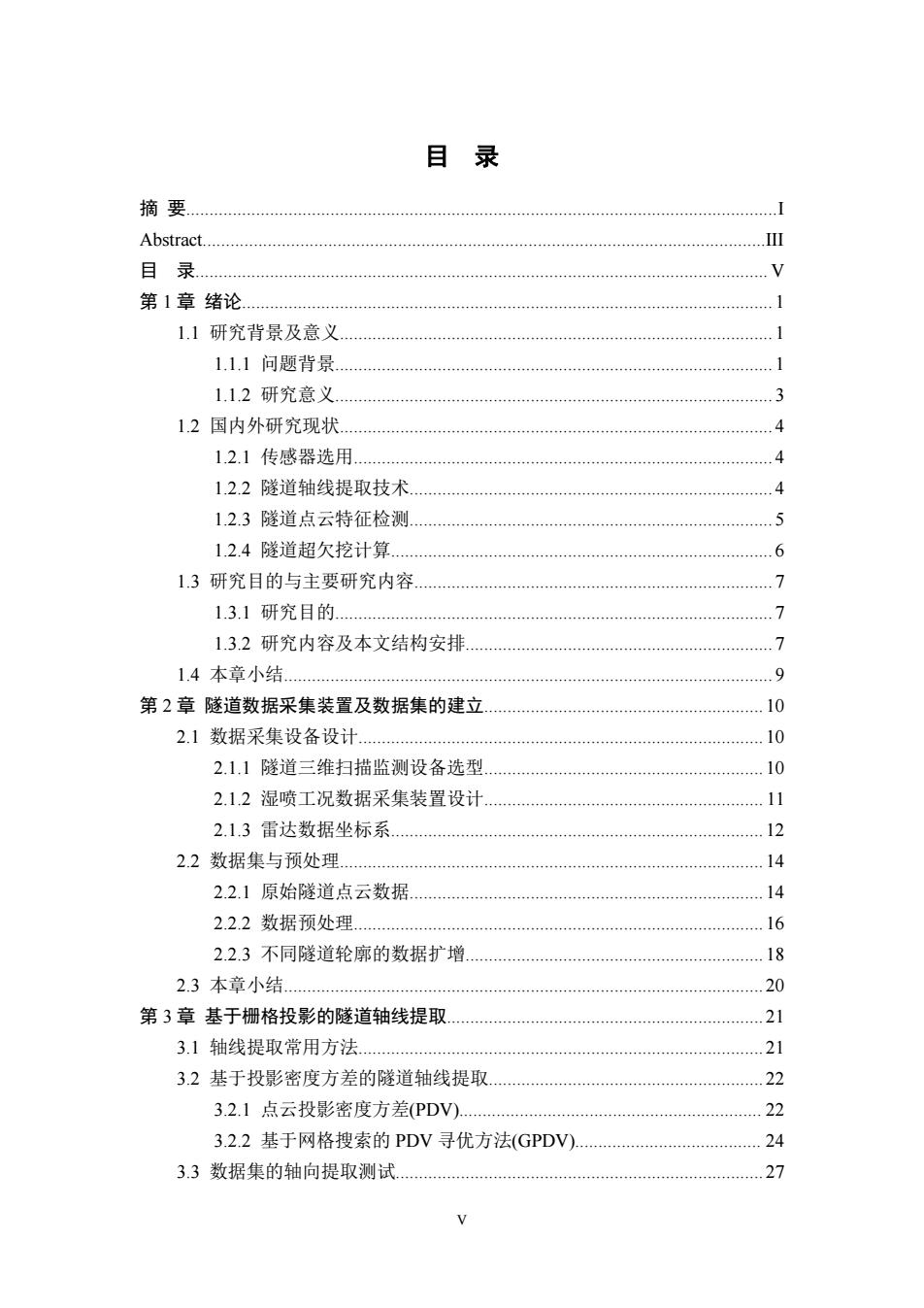
目录 摘要 Abstract 目录。 第1章绪论 1.1研究背景及意义 1.1.1问题背景 1.1.2研究意义 1.2国内外研究现状 .4 1.2.1传感器选用 1.2.2隧道轴线提取技术 .4 12.3隧道点云特征检测 1.2.4隧道超欠挖计算 6 1.3研究目的与主要研究内容 1 1.3.1研究目的 7 1.3.2研究内容及本文结构安排 7 1.4本章小结 第2章隧道数据采集装置及数据集的建立 10 2.1数据采集设备设计 .10 2.1.1隧道三维扫描监测设备选型 .10 2.1.2湿喷工况数据采集装置设计 11 2.13雷达数据坐标系 12 2.2数据集与预处理 .14 22.1原始隧道点云数据 14 2.2.2数据预处理 …l6 2.2.3不同隧道轮廓的数据扩增. 18 2.3本章小结 20 第3章基于栅格投影的隧道轴线提取 3.1轴线提取常用方法.… 21 32基于投影密度方差的隧道轴线提取 22 3.2.1点云投影密度方差(PDV) 22 3.2.2基于网格搜索的PDV寻优方法(GPDV 24 3.3数据集的轴向提取测试… .27
V 目 录 摘 要...............................................................................................................................I Abstract.........................................................................................................................III 目 录........................................................................................................................... V 第 1 章 绪论.................................................................................................................. 1 1.1 研究背景及意义............................................................................................. 1 1.1.1 问题背景.............................................................................................. 1 1.1.2 研究意义.............................................................................................. 3 1.2 国内外研究现状............................................................................................. 4 1.2.1 传感器选用.......................................................................................... 4 1.2.2 隧道轴线提取技术.............................................................................. 4 1.2.3 隧道点云特征检测.............................................................................. 5 1.2.4 隧道超欠挖计算.................................................................................. 6 1.3 研究目的与主要研究内容............................................................................. 7 1.3.1 研究目的.............................................................................................. 7 1.3.2 研究内容及本文结构安排.................................................................. 7 1.4 本章小结......................................................................................................... 9 第 2 章 隧道数据采集装置及数据集的建立............................................................ 10 2.1 数据采集设备设计....................................................................................... 10 2.1.1 隧道三维扫描监测设备选型............................................................ 10 2.1.2 湿喷工况数据采集装置设计............................................................ 11 2.1.3 雷达数据坐标系................................................................................ 12 2.2 数据集与预处理........................................................................................... 14 2.2.1 原始隧道点云数据............................................................................ 14 2.2.2 数据预处理........................................................................................ 16 2.2.3 不同隧道轮廓的数据扩增................................................................ 18 2.3 本章小结....................................................................................................... 20 第 3 章 基于栅格投影的隧道轴线提取.................................................................... 21 3.1 轴线提取常用方法....................................................................................... 21 3.2 基于投影密度方差的隧道轴线提取........................................................... 22 3.2.1 点云投影密度方差(PDV)................................................................. 22 3.2.2 基于网格搜索的 PDV 寻优方法(GPDV)........................................ 24 3.3 数据集的轴向提取测试............................................................................... 27
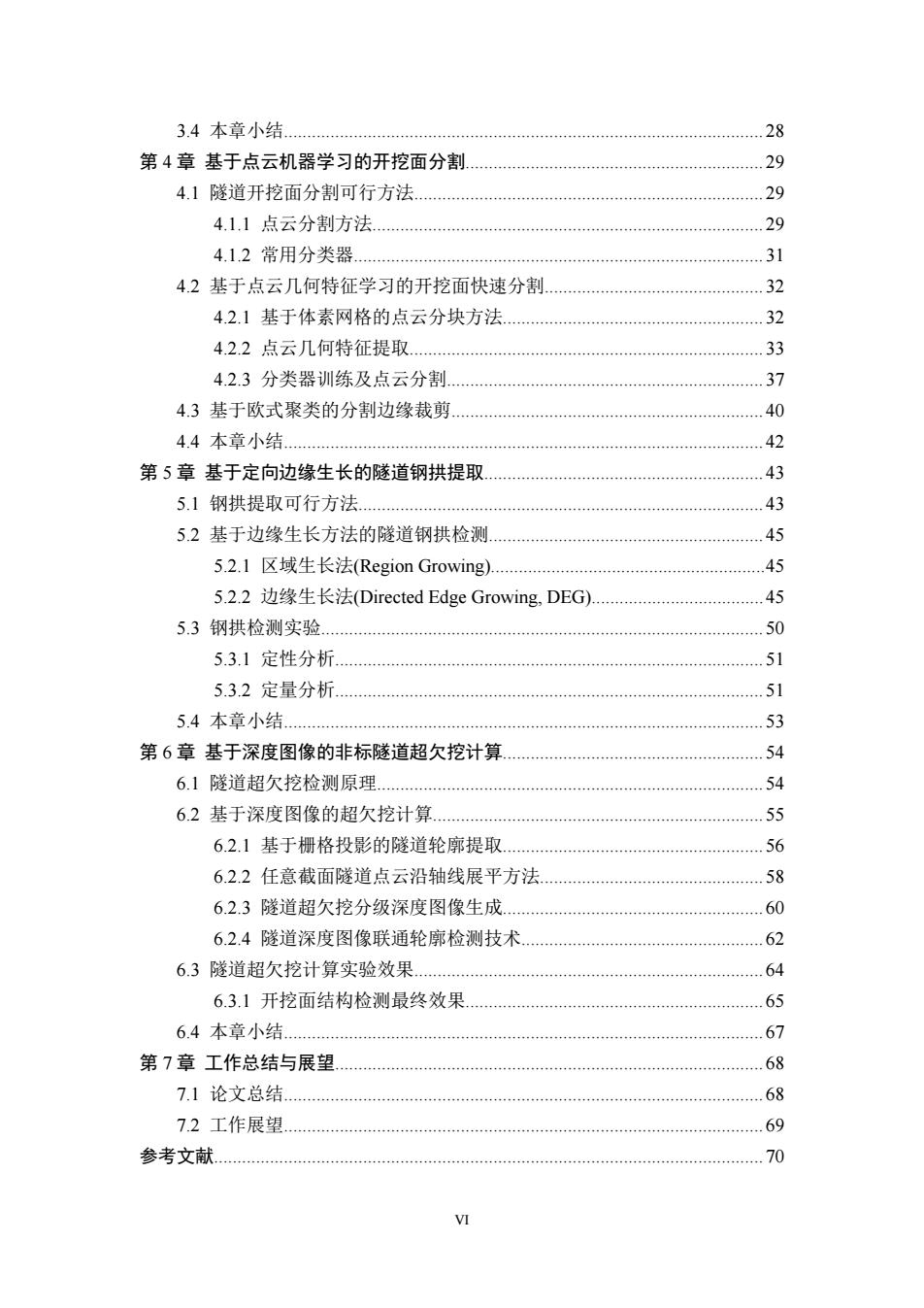
3.4本章小结 .28 第4章基于点云机器学习的开挖面分割 .29 4.1隧道开挖面分割可行方法 .29 4.1.1点云分割方法 29 4.1.2常用分类器 4.2基于点云几何特征学习的开挖面快速分割 32 4.2.1基于体素网格的点云分块方法 32 422点云几何特征提取 33 4.2.3分类器训练及点云分割 37 4.3基于欧式聚类的分割边缘裁剪 40 4.4本章小结 .42 第5章基于定向边缘生长的隧道钢拱提取 5.1钢拱提取可行方法 43 52基于边缘生长方法的隧道钢拱检测. 45 5.2.1区域生长法(Region Growing). 5.2.2边缘生长法(Directed Edge Growing.DEG). .45 5.3钢拱检测实验 50 5.3.1定性分析 51 5.3.2定量分析 .51 54本章小结 53 第6章基于深度图像的非标隧道超欠挖计算 .54 6.1隧道超欠挖检测原理。 62基于深度图像的超欠挖计算 55 6.2.1基于栅格投影的隧道轮廓提取 56 6.2.2任意截面隧道点云沿轴线展平方法 58 6.2.3隧道超欠挖分级深度图像生成 .60 6.2.4隧道深度图像联通轮廓检测技术 .62 6.3隧道超欠挖计算实验效果 .64 6.3.1开挖面结构检测最终效果 .65 64本章小结… 67 第7章工作总结与展望 68 7.1论文总结 68 7.2工作展望 .69 参考文献 .70
VI 3.4 本章小结....................................................................................................... 28 第 4 章 基于点云机器学习的开挖面分割................................................................ 29 4.1 隧道开挖面分割可行方法........................................................................... 29 4.1.1 点云分割方法.................................................................................... 29 4.1.2 常用分类器........................................................................................ 31 4.2 基于点云几何特征学习的开挖面快速分割............................................... 32 4.2.1 基于体素网格的点云分块方法........................................................ 32 4.2.2 点云几何特征提取............................................................................ 33 4.2.3 分类器训练及点云分割.................................................................... 37 4.3 基于欧式聚类的分割边缘裁剪................................................................... 40 4.4 本章小结....................................................................................................... 42 第 5 章 基于定向边缘生长的隧道钢拱提取............................................................ 43 5.1 钢拱提取可行方法....................................................................................... 43 5.2 基于边缘生长方法的隧道钢拱检测........................................................... 45 5.2.1 区域生长法(Region Growing)...........................................................45 5.2.2 边缘生长法(Directed Edge Growing, DEG).....................................45 5.3 钢拱检测实验............................................................................................... 50 5.3.1 定性分析............................................................................................ 51 5.3.2 定量分析............................................................................................ 51 5.4 本章小结....................................................................................................... 53 第 6 章 基于深度图像的非标隧道超欠挖计算........................................................ 54 6.1 隧道超欠挖检测原理................................................................................... 54 6.2 基于深度图像的超欠挖计算....................................................................... 55 6.2.1 基于栅格投影的隧道轮廓提取........................................................ 56 6.2.2 任意截面隧道点云沿轴线展平方法................................................ 58 6.2.3 隧道超欠挖分级深度图像生成........................................................ 60 6.2.4 隧道深度图像联通轮廓检测技术.................................................... 62 6.3 隧道超欠挖计算实验效果........................................................................... 64 6.3.1 开挖面结构检测最终效果................................................................ 65 6.4 本章小结....................................................................................................... 67 第 7 章 工作总结与展望............................................................................................ 68 7.1 论文总结....................................................................................................... 68 7.2 工作展望....................................................................................................... 69 参考文献...................................................................................................................... 70

攻读硕士期间主要研究成果 77 致谢 78
VII 攻读硕士期间主要研究成果...................................................................................... 77 致谢.............................................................................................................................. 78